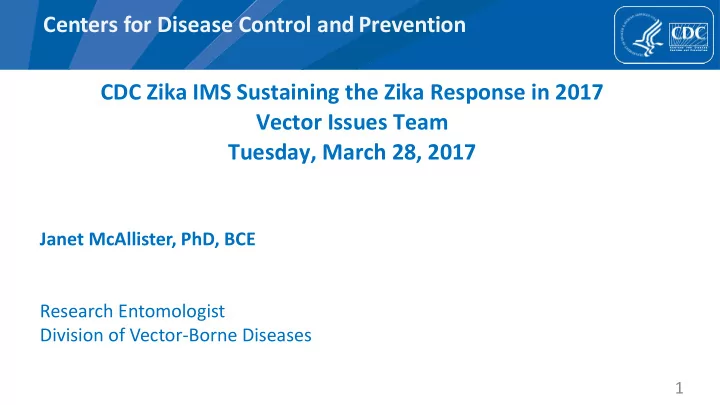

Centers for Disease Control and Prevention CDC Zika IMS Sustaining the Zika Response in 2017 Vector Issues Team Tuesday, March 28, 2017 Janet McAllister, PhD, BCE Research Entomologist Division of Vector-Borne Diseases 1
Opening Remarks 2
OVERVIEW Opening Remarks Updates to Zika Guidance Q&As Closing Remarks
CONUS Vector Control Activities 4
Preparation – Plan of Action Key partners identified? • Lines of communication worked • out? Public-facing material developed? • Workforce trained? • Plan exercised? • Prior knowledge of species • distribution, abundance, and resistance status? Have you identified resources? • Source: www.cdc.gov/zika/fs-posters/index.html
Preparation – AMCA Training • New Best Management Practices • Master Trainers • 10 Regional “Train the trainers” events • Web-based training and certification in development • Visit www.mosquito.org for more information Source: www.mosquito.org
Suspected and Confirmed Cases • Initiate vector control within 150m radius of case • The same integrated approach is used for 1 case, a small cluster, and widespread cases • Intensity of control and geographic scale will vary based on the situation and may change over time Source: https://www.cdc.gov/zika/vector/vector-control.html
Surveillance First wave of ELC money to • support surveillance went out in early August 2016, supplemental funds in December 2016 MosquitoNet beta tested in • Nov/Dec 2016 January 2017, started enrolling • users Repeated survey of distribution • of Stegomyia species in Dec Source: https://wwwn.cdc.gov/Arbonet/MosquitoNET/
Surveillance ELC funds were distributed to • develop or enhance mosquito vector surveillance and insecticide resistance testing Data compiled will be used to: • Develop more accurate knowledge • of where and during what time of the year Ae. aegypti and Ae. albopictus occur in the United States and are most abundant Define the extent of insecticide • resistance of Zika virus mosquito vectors throughout the United States Source: www.cdc.gov/zika/vector/control.html
Aedes aegypti • 38 new county records since spring survey, primarily from Texas • Illinois and Alabama added their first county records • Represents a 21% increase in reported counties • 40 counties added additional year records
Aedes albopictus • 127 new counties since spring survey, primarily from Kansas, Texas, Mississippi, Arkansas • Represents a 10% increase • 183 counties have added additional year data.
Mosquito Surveillance in Texas – a ELC Funding at Work Based on data from 2000-2016, 141 • counties in Texas have documented the presence of one or both Stegomyia species ( Ae. aegypti and Ae. albopictus): 65 counties have documented the presence of both • species 55 counties have documented the presence of Ae. • albopictus only 21 counties have documented the presence of Ae. • aegypti only Stegomyia surveillance project • participants added species documentation to 56 counties in 2016.
Insecticide Resistance • Widespread but focal problem • Not well documented across United States • Starting with easiest, most basic test for mosquito control districts to adopt: CDC bottle bioassay Source: https://www.cdc.gov/zika/pdfs/guidelines-for-aedes-surveillance-and-insecticide-resistance-testing.pdf
Vector Control Activities • Trap and equipment purchases • Chemical purchases • Supplemental contracts • Entomologic expertise
Questions/Discussion 15
Closing Remarks 16
17
Thank You! For more information, contact CDC 1-800-CDC-INFO (232-4636) TTY: 1-888-232-6348 www.cdc.gov The findings and conclusions in this report are those of the authors and do not necessarily represent the official position of the Centers for Disease Control and Prevention. 18
Recommend
More recommend